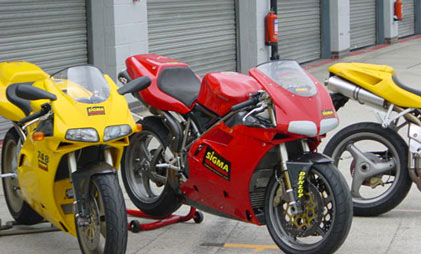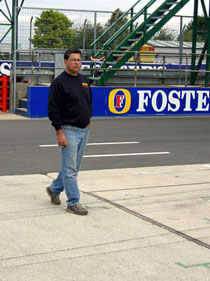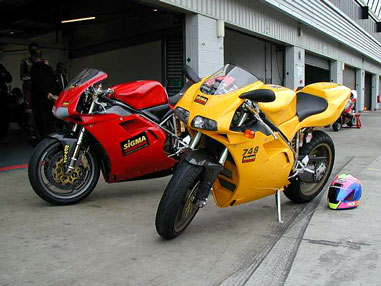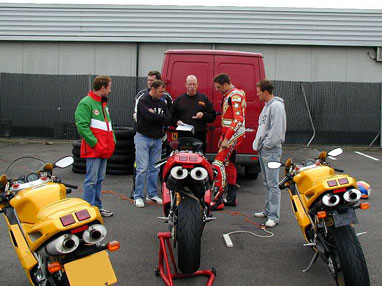|
All engines come with basic characters, I can remember the days of street going performance two strokes, peaky, light and fast. There were the big four stroke trail bike singles,
torquey but lazy. In cars the range goes from big chugging US built V8's through to things like Fiats Uno Turbo; 1100ccs of revvy lunacy.
 The Ducati range is just the same, a two-valve range with the humble 600cc at the bottom
and the 944cc ST2 engine at the top; the new 1000cc 2 valve Multistrada being a further evolution; good torquey (well almost in the case of the 600!) easy to ride V twins. The four valvers have the 748Bip at the
bottom of the range and the new 998R at the top, again all with different characters, all with differing marketing targets and at different price levels (although as I have said on this site
before, I cannot really understand why a 996 Bip cost any more to make than a 748 Bip, but maybe I am just too logical). The Ducati range is just the same, a two-valve range with the humble 600cc at the bottom
and the 944cc ST2 engine at the top; the new 1000cc 2 valve Multistrada being a further evolution; good torquey (well almost in the case of the 600!) easy to ride V twins. The four valvers have the 748Bip at the
bottom of the range and the new 998R at the top, again all with different characters, all with differing marketing targets and at different price levels (although as I have said on this site
before, I cannot really understand why a 996 Bip cost any more to make than a 748 Bip, but maybe I am just too logical).
Amongst the 4 valves there are several ingredients that decide each bikes character. Gearbox, cams/valves and bore stroke combinations being the main ones. As we pointed out in our 853Bip article this means there are some combinations that the Factory have not produced.
Some of these combinations are very, very good fun indeed. 853's are our favourite, the torque and punch of the 916 series of engines and the revs and attitude of the 748.
Our take on the 748/853Bip is in our article 'the best bike Ducati never made' and we meant it. Having had real fun with some of these (we build a dozen or so a
year), we decided that Ducatis top of the range 748R could do with some of the same treatment. I have spoken to many owners of these bikes and the most common complaint is that despite its
brilliantly revvy nature it still gets outdragged on the straight bits by the likes of Aprilia Milles; and being good Ducatisti we can't allow that can we?
To understand the logic behind our preferences for this engine a little revision is called for. We raced a Ducati 748RS factory
Supersport machine in 2000 and we actually got it going quite well, the full technical details are in the 748R/748RS page.
For the purposes of this article though we will concentrate on the main power production differences between the RS racer and the R roadbike; these are cams, head porting and exhaust
. The rest of the mods on the 748RS version are to lighten things up or make the bike more usable in racing.
 The whole 748R engine is designed as a homologation
special, it is a deliberately detuned racer, nor the other way round. All the modifications are driven by the terms of the FIM Supersport rule book. The rules state
that standard size valves and standard lift (but not duration) cams must be used, port modifications and different exhaust pipes are however allowed. The whole 748R engine is designed as a homologation
special, it is a deliberately detuned racer, nor the other way round. All the modifications are driven by the terms of the FIM Supersport rule book. The rules state
that standard size valves and standard lift (but not duration) cams must be used, port modifications and different exhaust pipes are however allowed.
Ducati therefore made an extreme 748cc racer and calmed it down a bit for the road. The racer has a fully ported head, this size of port on a road going 748 would produce a bike with absolutely no bottom end power
whatsoever, as anything under 6000 rpm is of no consequence on track it doesn't matter to the racer. The road 748R therefore has nice big 36mm valves, because the rulebook wont let you change them, fed by
nice little 32mm ports, because the rule book will let you change them. This keeps the inlet port gas speed up (a bit like putting your finger over the end of a garden
hose) which allows the bike to run vaguely properly low down.
Short duration high lift cams are next, the breathing coming from the big valve area/short open time method of inlet timing rather than Ducati's
historic preference for small valves and long duration cams. The racer has cams that use the benefits of Desmo to its absolute limit, the valves open very quickly but they are smashed shut
by one of the quickest 'jerk's ever inflicted on a valve. This violent opening and shutting is designed to let the RS engine breathe as efficiently as possible but to do away with the long
duration cam timing that typically limits the width of the powerband. The result is a beautiful flat power curve but while on the outside all is serene, smooth power the engine is literally smashing
the valves and the rockers to pieces inside, in the official maintenance schedule all the valves and rockers are replaced every 750km. The RS cams are not suitable for anything other than a
racer that is rebuilt every race meeting, by someone with a bigger budget than the one we've got.
 So, what can be done? So, what can be done?
We want a bike that produces the brilliant power and fun of the racer but it would be nice if it didn't need a total rebuild every 750 km…………So in the best traditions of having your cake and eating it that's what we
built.
The 853R is a 748R engine with standard street 748R cams fitted with our 853 pistons and with a full works style porting job. On the street after all you do not suffer the artificial restrictions of racing
categories. The valves are standard, they can be because the standard cams are not making them do any more work than Ducati asked them to
in the first place. Modifying the ports does not cause any more wear anywhere and the 853 pistons are dragging 12% more gas through those ports than the 748RS racer did at equivalent
RPM's. As we describe in the 748/853Bip tech article the engine is a shrunken 916 any way so
there is no problem with the strength of the various components (actually, to be strictly accurate, the engine on a 748R is a shrunken 996; but that can only be for the better considering the
power coming out of this thing).
 The really difficult bits in this equation are finding the right pistons, getting
the porting right and getting the fueling to match; the build quality matters too with the assembly being carried out to our Full Monty specs…. The really difficult bits in this equation are finding the right pistons, getting
the porting right and getting the fueling to match; the build quality matters too with the assembly being carried out to our Full Monty specs….
The combined effect is to produce the same peak power as the 758RS but at a slightly more conservative RPM, it also means that the torque is up, by nearly 20% all through the range. This allows the valves to live
longer, they are not being asked to any more than they were in the stock bike, and the rods are happy because they are not hauling any more weight around, or being asked to rev any higher, pretty cool really…….
In standard form the 748R and the 748RS produce similar power up to 8500 rpm; the 853 murders them both up to 8000 rpm and is only caught by the 748RS at 11500rpm. In terms of
overall superiority the 853R outpowers the 748R by 5 bhp down at 5000 rpm and between 10 and 15 bhp all through the rest of the rev-range until the peak.
Torque 853R -vs- 748R
BHP 853R -vs- 748R
The pistons (as is our usual practice) are the same weight as the standard items, the valves are not modified and the Eprom is dead accurate, you will need a decent exhaust system though.
These results are with a racing 54mm system, but our tests have shown that this makes almost identical power to a 50mm system while being quieter at 102db, as the FIM rules require. There
would be a possible 2-3 bhp loss compared to these figures with a 50mm intermediate system but this would have the happy side effect of improving low end carburetion and throttle response.
What these bare figures do not get across is the complete transformation in the attitude of the bike, it is making comparable torque to a 916, and the same peak, more or less, as a 996SPS,
but its doing it in a completely different revvy, fizzy barking mad compared fashion to these long stroke engines, just like the 748RS, but without the pain. Marvellous.
Success; reliable RS power
Just think, inside every 748R there's one of these trying to get out
Neil Spalding
|